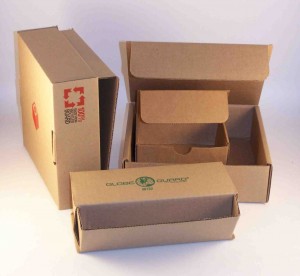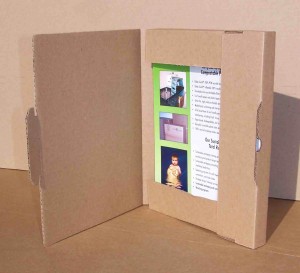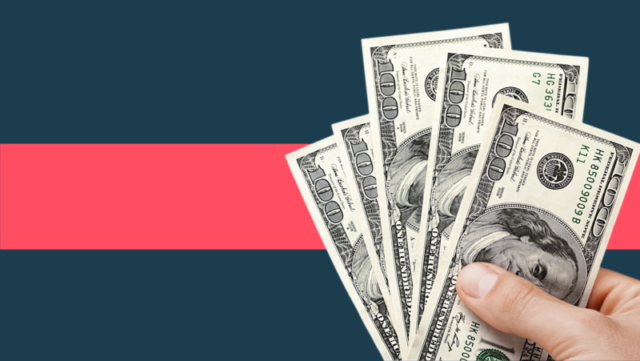 We enjoy creating eco friendly printed, die cut containers, but they are not exempt from many of the same potential costs and problems of non-green die cut designs and solutions.
We enjoy creating eco friendly printed, die cut containers, but they are not exempt from many of the same potential costs and problems of non-green die cut designs and solutions.
During a recent phone conversation with a potential new client, I could hear the disappointment in my contact’s voice when I informed him he would probably have to invest several thousands of dollars in printing plates and cutting dies even before his first box was cut or printed.
This situation was unique and extreme because we were talking about an oversized, 12” tall, stackable display tray that would be palletized for a large retailer. The two-color copy the customer wanted printed on each panel of course added some cost, but not as much as you might expect. As I have said many times, ink is cheap, but set up time and plates are not. This unfortunately also holds true for cutting dies for new package designs, whether the container being designed is a counter top display, tuck mailer, tray or special shipping box.
Things to Keep in Mind When Designing a New Package
The cost of a cutting die is determined by the number of lineal inches of steel rule that are needed. All of the angles, curves, openings and details your graphic designer just loves will add significant cutting die cost. Graphic designers, especially those inexperienced in packaging, tend to forget this when they develop a “new and unique look.” In the case of the client above, we were talking about a “one up” layout, but the tray is huge so a lot of lineal inches of cutting die are necessary. Rough estimate in this case – $1,800.
 Beware though because even on a small die cut box, there are times when the manufacturer needs to produce it more efficiently by running it 2, 4, 6 up or even more, requiring more steel rule to be used. If the volume is substantial the larger die investment usually pays off quickly with a lower product cost, but it is a good idea to determine that before vendors are selected and commitments are made.
Beware though because even on a small die cut box, there are times when the manufacturer needs to produce it more efficiently by running it 2, 4, 6 up or even more, requiring more steel rule to be used. If the volume is substantial the larger die investment usually pays off quickly with a lower product cost, but it is a good idea to determine that before vendors are selected and commitments are made.
Plate cost is determined by square inches of surface being printed and the number of colors being printed. I am simplifying this part of the printing plate costing process, and yes there are other factors that come into play such as the type of printing process being used, the plate composition, etc., but what I have written will prove true well more than 90% of the time.
Our friend with the oversized tray was printing a lot of square inches of surface, and the two colors he wanted would require two plates so the initial plate cost estimate (subject to artwork review) turned out to be $1,200 to $1,500.
You pay for all the square inches used, even the scrap. Die cut boxes are cut from what is called a “blank.” That is the larger master sheet from which the one, two, or more boxes are cut. Your box may only require let’s say 400 square inches of board, but if the blank is 800 square inches because of the design you selected, that is the board price your box cost is based on.
Without getting into a lot of geometry that quite frankly I’ve never understood, keep one thing in mind – the taller the box or tray you make, the more wasteful a die cut design and style become. That is not only costly, but also it is not very green. So perhaps the very first question you should be asking is, “is a die cut box really the best style for my product?”
What Can You Do to Avoid Cost and Problems?
1. Seek Experience. Don’t hesitate to ask for samples of previous work. The same company that makes outstanding unprinted, brown RSC boxes may have little experience in die cut designs.
2. At the same time, be cautious of a packaging salesperson who has the answer before he has asked all the necessary questions about you, and your customer, as well as how and where you ship.
3. Begin with structural design of the box, NOT the graphic design, and be open to suggestions and revisions. BTW, asking a box designer to make a box to fit art work your friend made for you for free is like asking a shoe maker to create a pair of shoes for you, using your favorite pair of socks as a template.
A good supplier understands these cost issues and works to minimize them for you. We recently designed two die cut boxes for a potential new customer on the west coast. We decided that one of the sizes might be a good addition to our stock line up so we offered to split the die cost. It was perhaps an unusual offer but one that was fair to all parties involved and much appreciated by our new customer.
Creativity throughout the entire process is never a waste of time or energy!



